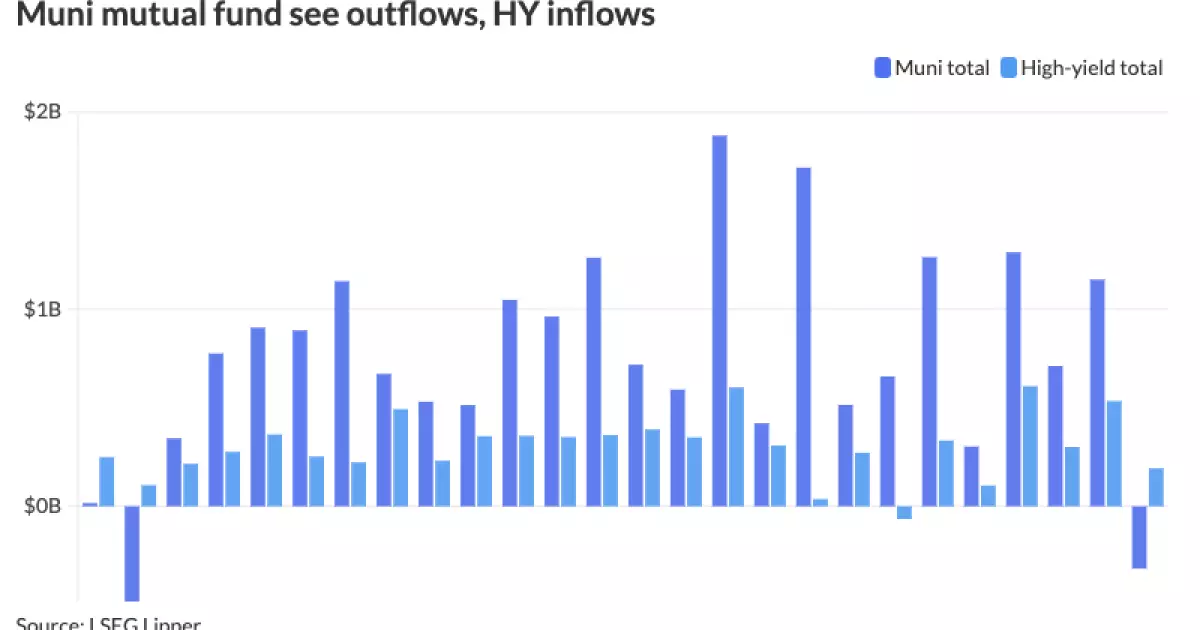The municipal bond (muni) market has recently experienced notable fluctuations, particularly in the context of rising U.S. Treasury yields and an apparent shift in investor sentiment. As seen in the data from the week preceding December 11, the muni market recorded substantive losses, with the most significant changes occurring on Thursday. This trend has raised questions regarding future performance as the market adapts to prevailing economic conditions, including changes in Federal Reserve policies.
In the past week, triple-A yield curves were considerably affected, signaling a domino effect of investor outflows that impacted municipal mutual funds for the first time since the previous summer. The reported outflows amounting to $316.2 million have disrupted a previously steady inflow streak that had persisted for 23 weeks. Contrasting this, high-yield municipal bond funds recorded inflows of $192.3 million—a decline from the previous week but indicative of continued interest in higher-risk bonds.
The interaction between the municipal bond market and the U.S. Treasury (UST) system has been controlled by the Federal Reserve’s monetary policy. Historically, shifts in Treasury yields have had direct repercussions on muni yields. As interest rates began to rise following the Fed’s tightening measures, investors became increasingly sensitive to market changes. Mark Paris, the chief investment officer and head of municipals at Invesco, highlighted this sensitivity, connecting the underperformance of munis to prolonged periods of negative Treasury yields.
This relationship suggests that future dynamics in the muni market will be profoundly influenced by adjustments in Treasury rates. Observers now wonder whether the current ratios between municipal bonds and UST can remain stable if Treasury rates decrease further. As historical trends indicate, changes in investor sentiment toward Treasury bonds can lead to significant revaluations in the municipal bond space, rendering them vulnerable to broader market pressures.
The volatility in the muni market is further amplified by recent behaviors in money markets. Reports of a surge in bid-wants to $2.41 billion—the highest in over two years—hint at increased market activity, likely driven by a need for cash from recent deals and preparations for year-end portfolio adjustments. This sharp increase suggests that investment managers are repositioning their portfolios as the year winds down, a situation often exacerbated by end-of-year tax considerations.
Money market yields have shown increasing signs of instability, exemplified by daily floater rates rising over 100 basis points. Contrastingly, yields from tax-exempt municipal money market funds faced significant withdrawals, totaling $1.25 billion, necessitating close monitoring of investor behavior as it continues to evolve. New insights provided by senior fixed-income portfolio manager Kim Olsan illustrate a landscape where indicative yields are beginning to show favorable discrepancies compared to recent maturities, raising further questions about the sustainability of investment strategies in this shifting terrain.
As we look ahead, the municipal bond market is poised for significant changes in 2024. Expectations for issuance are set to reach record levels, driven by a robust demand for financing as municipalities embark on diverse projects. While much of the current supply has been absorbed, analysts predict a return of activity post-holidays, especially with larger deals like the $1.5 billion bond issuance by the New York City Transitional Finance Authority on December 17.
However, the overarching landscape will depend heavily on where Treasury rates go from this point. With projections estimating a substantial influx of issuance nearing $500 billion in 2025, the munis market could see an oversubscription if investors act preemptively to navigate potential changes to tax exemptions. The convergence of supply pressures and shifting interest rates may create an unsteady environment, making clarity on future trends a necessity for investors.
The municipal bond market is currently in a state of flux, influenced by internal dynamics and external economic pressures. Market players must remain vigilant, analyzing yield movements and investor behaviors as tools for informed decision-making. With the complexities of rising UST yields and an evolving fiscal landscape, the pathway forward for munis will likely require strategic adaptability and foresight.
Municipal bonds have traditionally been a conservative investment choice, but present market conditions necessitate a reassessment of risk and performance expectations. As the year concludes, the focus on responding to rate changes and investor sentiments becomes paramount for those navigating the intricacies of the muni market. The ongoing interaction between market forces will ultimately dictate the trajectory for the months ahead.


Leave a Reply